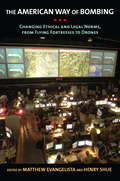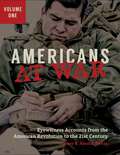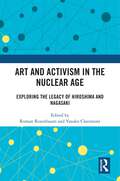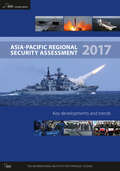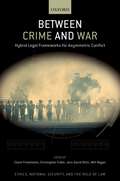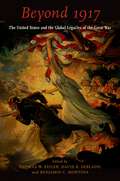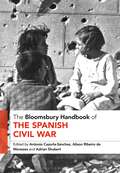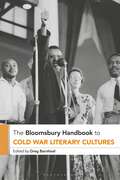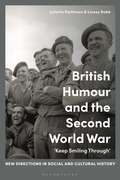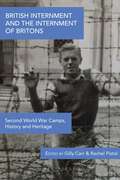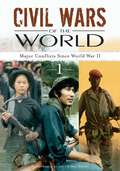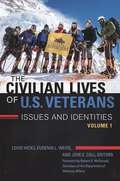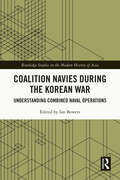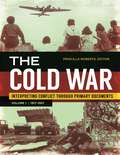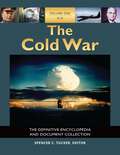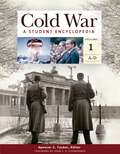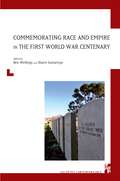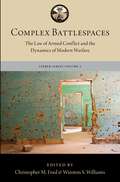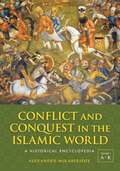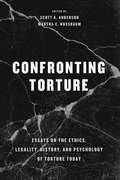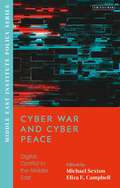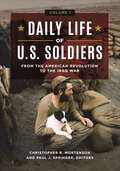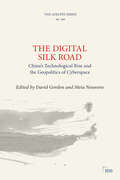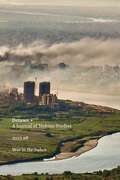- Table View
- List View
The American Way of Bombing: Changing Ethical and Legal Norms, from Flying Fortresses to Drones
Aerial bombardment remains important to military strategy, but the norms governing bombing and the harm it imposes on civilians have evolved. The past century has seen everything from deliberate attacks against rebellious villagers by Italian and British colonial forces in the Middle East to scrupulous efforts to avoid "collateral damage" in the counterinsurgency and antiterrorist wars of today. The American Way of Bombing brings together prominent military historians, practitioners, civilian and military legal experts, political scientists, philosophers, and anthropologists to explore the evolution of ethical and legal norms governing air warfare. Focusing primarily on the United States—as the world’s preeminent military power and the one most frequently engaged in air warfare, its practice has influenced normative change in this domain, and will continue to do so—the authors address such topics as firebombing of cities during World War II; the atomic attacks on Hiroshima and Nagasaki; the deployment of airpower in Iraq, Afghanistan, and Libya; and the use of unmanned drones for surveillance and attacks on suspected terrorists in Pakistan, Yemen, Sudan, Somalia, and elsewhere.
Americans at War [3 volumes]: Eyewitness Accounts from the American Revolution to the 21st Century [3 volumes]
This unprecedented compilation of eyewitness accounts records the thoughts and emotions of American soldiers spanning nearly 250 years of national history, from the American Revolution to the Afghanistan War.Understanding primary sources is essential to understanding warfare. This outstanding collection provides a diverse set of eyewitness accounts of Americans in combat throughout U.S. history. Offering riveting true stories, it includes accounts from participants in the American Revolution, the War of 1812, the Indian Wars, the Mexican-American War, the Civil War, the Spanish American War and Philippine Insurrection, World War I, World War II, the Korean War, the Vietnam War, The Persian Gulf War, the Afghanistan War, and the Iraq War.Most eyewitness accounts of war currently available to the public are those of writers who enjoy higher military rank. Americans at War addresses this imbalance between officers' accounts and enlisted men's accounts by invoking oral history archives. Contextual essays and timelines allow the reader to place the accounts in time and place, while the entries themselves allow the reader to experience the thoughts and emotions of Americans who engaged in combat.
Art and Activism in the Nuclear Age: Exploring the Legacy of Hiroshima and Nagasaki
This book explores the contemporary legacy of Hiroshima and Nagasaki following the passage of three quarters of a century, and the role of art and activism in maintaining a critical perspective on the dangers of the nuclear age. It closely interrogates the political and cultural shifts that have accompanied the transition to a nuclearized world. Beginning with the contemporary socio-political and cultural interpretations of the impact and legacy of the destruction of Hiroshima and Nagasaki, the chapters examine the challenges posed by committed opponents in the cultural and activist fields to the ongoing development of nuclear weapons and the expanding industrial uses of nuclear power. It explores how the aphorism that ‘all art is political’ is borne out in the close relation between art and activism. This multi-disciplinary approach to the socio-political and cultural exploration of nuclear energy in relation to Hiroshima/Nagasaki via the arts will be of interest to students and scholars of peace and conflict studies, social political and cultural studies, fine arts, and art and aesthetic studies.
Asia-Pacific Regional Security Assessment 2017
This book offers an analysis of the four central regional security themes relevant to the policy-focussed discussions at the annual IISS Shangri-La Dialogue. Namely: The evolving roles of the United States and China in Asia-Pacific security;Responses by the US and regional states to regional security tensions, particularly in the South China Sea;Emerging security questions relating to nuclear weapons, missiles and military cyber capabilities;The prospects for regional security cooperation, including the challenges for the ASEAN-centred architecture.
Between Crime and War: Hybrid Legal Frameworks for Asymmetric Conflict (ETHICS NATIONAL SECURITY RULE LAW SERIES)
The threat posed by the recent rise of transnational non-state armed groups does not fit easily within either of the two basic paradigms for state responses to violence. The civilian paradigm focuses on the interception of demonstrable immediate threats to the safety of others. The military paradigm focuses on threats posed by collective actors who pose a danger to the state's ability to maintain basic social order and, at times, the very existence of the state. While the United States has responded to the threat posed by non-state armed groups by using tools from both paradigms, it has placed substantially more emphasis on the military paradigm than have other states. While several reasons may contribute to this approach, one may be the assumption that a state must use each set of tools strictly according in accordance with the principles that underlie each paradigm. Implicit in this assumption may be the sense that the only alternative to the civilian paradigm is the unqualified military one. The chapters in this book suggest, however that we need not see the options as confined to this binary choice. It may be profitable to consider borrowing elements from each paradigm on some occasions to act more expansively than the conventional civilian paradigm allows, but less expansively than the conventional military paradigm would permit. At the same time, the mixing of the categories comes with its own ethical and legal risks that should be scrutinized.
Beyond 1917: The United States and the Global Legacies of the Great War
A massively destructive and transformative event, the First World War left in its wake many legacies. Beyond 1917 explores both the consequences of the war for the United States (and the world) and American influence on shaping the legacies of the conflict in the decades after US entry in 1917. From the fields, seas, and airspace of battle, we live today with the consequences of the Great War's poison gas, post-traumatic stress disorder, and technological inventions such as air bombardment of civilians, submarine and tank warfare, and modern surgical techniques. Conscription, pacifism, humanitarian campaigns, and socialist movements emerged from the war to shape politics within countries for decades to come. Governments learned the value of propaganda, both in print and in film. Society changed: women were emancipated in some countries and citizenship was altered in many places, while aristocracy and monarchies went into decline. European empires were transformed and in some cases destroyed; in the Middle East, the change was enormous, beginning with the final collapse of Ottoman hegemony in the region. Fascism and communism, mass migration, independence, militarism, an influenza epidemic, the rise of Wall Street and American economic power, a slowdown in the process of globalization, and the pursuit of world peace by an organization based on collective security numbered among the most significant and lasting legacies of this conflict. Beyond 1917 explores how and why the war has become an integral milepost for human history, reflects the importance of the conflict, the forces that led to it, and the forces it unleashed. On the occasion of the centennial commemorations, an international group of scholars considers the long-term policy, political, social, economic, and cultural consequences of the war for the United States itself and for the world. In addition to interpretive essays, the volume provides a comprehensive bibliography and timeline of events.
The Bloomsbury Handbook of the Spanish Civil War (Bloomsbury Handbooks)
In 25 innovative thematic essays, The Bloomsbury Handbook of the Spanish Civil War sees an interdisciplinary team of scholars examine a conflict that, more than 80 years after its conclusion, continues to generate both scholarly and public controversy.Split into four main sections covering Military and Diplomatic Issues, Society and Culture, Politics, and Debates, the volume offers a number of unique features. It is unprecedented in its comprehensiveness and includes chapters on topics that are rarely, if ever, explored in the literature of the field: humanitarianism, children and families, material conditions, the decimation of elites, archives and sources, archaeological approaches, digital approaches, public history, and cultural studies approaches. Instead of discussing each of the two warring sides, Republicans and Francoists, separately, as is so often the case, the book's thematic structure means that these opposing forces are examined together, facilitating comparison and fresh understanding in numerous areas of study. Contributors from the UK, the USA, Canada, Spain and Denmark also analyse the major controversies and disputes surrounding each topic as part of a detailed exploration of one of the seminal events of the 20th century.
The Bloomsbury Handbook to Cold War Literary Cultures (Bloomsbury Handbooks)
Adopting a unique historical approach to its subject and with a particular focus on the institutions involved in the creation, dissemination, and reception of literature, this handbook surveys the way in which the Cold War shaped literature and literary production, and how literature affected the course of the Cold War. To do so, in addition to more 'traditional' sources it uses institutions like MFA programs, university literature departments, book-review sections of newspapers, publishing houses, non-governmental cultural agencies, libraries, and literary magazines as a way to understand works of the period differently. Broad in both their geographical range and the range of writers they cover, the book's essays examine works of mainstream American literary fiction from writers such as Roth, Updike and Faulkner, as well as moving beyond the U.S. and the U.K. to detail how writers and readers from countries including, but not limited to, Taiwan, Japan, Uganda, South Africa, India, Cuba, the USSR, and the Czech Republic engaged with and contributed to Anglo-American literary texts and institutions.
British Humour and the Second World War: ‘Keep Smiling Through’ (New Directions in Social and Cultural History)
This book skilfully combines cutting-edge historical research by leading and emerging researchers in the field to investigate the utilization of British humour during the Second World War as well as its legacy in British popular culture.Juliette Pattinson and Linsey Robb bring together case studies that address a variety of situations in which humour was generated, including wartime jokes, films, radio, cartoons and private drawings, as well as post-war recollections, museum exhibitions and television comedy. By adopting an original interpretative framework of various wartime and post-war sites, this books opens up the possibility for a more variegated, richer analysis of Britain's wartime experience and its place thereafter in the cultural imagination.Through the lens of humour, this book promises to add critical nuance to our understanding of the functioning of British wartime society. Covering sources such as The British Cartoon Archive, BBC World War II People's War Archive and The Ministry of Information, and including analysis of the lasting role of comedy in Britain's memories and depictions of the war, the result is a rich addition to existing literature of use to students and scholars studying the cultural history of war.
British Internment and the Internment of Britons: Second World War Camps, History and Heritage
This edited volume presents a cutting-edge discussion and analysis of civilian 'enemy alien' internment in Britain, the internment of British civilians on the continent, and civilian internment camps run by the British within the wider British Empire. The book brings together a range of interdisciplinary specialists including archaeologists, historians, and heritage practitioners to give a full overview of the topic of internment internationally.Very little has been written about the experience of interned Britons on the continent during the Second World War compared with continentals interned in Britain. Even fewer accounts exist of the regime in British Dominions where British guards presided over the camps. This collection is the first to bring together the British experiences, as the common theme, in one study. The new research presented here also offers updated statistics for the camps whilst considering the period between 1945 to the present day through related site heritage issues.
Civil Wars of the World [2 volumes]: Major Conflicts since World War II [2 volumes]
This unique two-volume reference is the most authoritative, up-to-date resource available for information and data on the most volatile civil wars around the globe since World War II.At a time when historians are devoting more and more research to conflicts within nations, Civil Wars of the World: Major Conflicts since World War II is an invaluable addition to the available resources. In two volumes, it ranges around the globe to cover the most volatile and deadly civil wars of the past 60 years, including the bloody impasses in the Middle East; devastating tribal warfare in Africa; Cold War–fueled conflicts in Eastern Europe and Asia; the seemingly unbreakable cycle of rebellion and repression in some regions of Latin America; and more.Civil Wars of the World moves country by country to describe the causes, course, and consequences of internal conflicts within each nation. Coverage includes the historical background of each country, geographic and economic factors, descriptions of rebel groups and governments (e.g., regime type, size of military, capacity), terrorism, foreign and/or intergovernmental organization (IGO) intervention (UN, foreign support for rebels), foreign aid, and prospects for peace.
The Civilian Lives of U.S. Veterans [2 volumes]: Issues and Identities [2 volumes]
In this book, 50 experts study the lives of U.S. veterans at work, at home, and in American society as they navigate issues regarding health, gender, public service, substance abuse, and homelessness.The aftermath of modern war includes a population of veterans whose needs last for many decades—far longer than the war itself. This in-depth study looks at life after the military, considering the dual conundrum of a population benefiting from the perks of their duty, yet continuing to deal with trauma resulting from their service, and of former servicemen and servicewomen trying to fit into civilian life—in a system designed to keep them separate. Through two comprehensive volumes, essays shed light on more than 30 topics involving or affecting former servicemen and servicewomen, offering a blueprint for the formal study of U.S. veterans in the future. Contributions from dozens of experts in the field of military science cover such issues as unemployment, homelessness, disability, access to higher education, health, media portrayal, criminal justice, substance abuse, guns, suicide, and politics. Through information gleaned from surveys, interviews, participant observations, secondary analyses, and content analyses, the chapters reveal how veterans are able to successfully contribute to civilian life and show how the American workforce can benefit from their unique set of skills.
Coalition Navies during the Korean War: Understanding Combined Naval Operations (Routledge Studies in the Modern History of Asia)
This book presents a detailed assessment of the role of navies in the Korean War. It highlights that, despite being predominantly a land war, navies played a vital part. Moreover, the naval war was not solely a U.S. operation. Smaller navies from many countries made important contributions both in supporting the United States and carrying out independent and combined naval operations. This subject holds special importance since current Western strategic thinking and capabilities emphasise the necessity of combined naval operations involving multiple navies in any potential future naval conflict. The example set by the Korean War therefore offers valuable insights into the operational and strategic problems, and benefits and opportunities of contemporary and future combined coalition naval operations.
The Cold War [2 volumes] [2 volumes]: 2 volumes [2 volumes]
This detailed two-volume set tells the story of the Cold War, the dominant international event of the second half of the 20th century, through a diverse selection of primary source documents.One of the most extensive to date, this set of primary source documents studies the Cold War comprehensively from its beginning, with the emergence of the world's first communist government in Russia in late 1917, to its end, in 1991. All of the key events, including the Berlin Blockade, the Korean War, the Cuban Missile Crisis, the Vietnam War, and the nuclear arms race, are discussed in detail. The primary sources provide insight into the thinking of all participants, drawing on Western, Soviet, Asian, and Latin American perspectives.In The Cold War: Interpreting Conflict through Primary Documents primary documents are organized chronologically, allowing readers to appreciate the ramifications of the Cold War within a clear time frame. Extensive interpretive commentary provides in-depth background and context for each document. This work is an indispensable reference for all readers seeking to become deeply knowledgeable about the Cold War.
The Cold War [5 volumes]: The Definitive Encyclopedia and Document Collection [5 volumes]
This sweeping reference work covers every aspect of the Cold War, from its ignition in the ashes of World War II, through the Berlin Wall and the Cuban Missile Crisis, to the collapse of the Soviet Union in 1991.The Cold War superpower face-off between the Soviet Union and the United States dominated international affairs in the second half of the 20th century and still reverberates around the world today. This comprehensive and insightful multivolume set provides authoritative entries on all aspects of this world-changing event, including wars, new military technologies, diplomatic initiatives, espionage activities, important individuals and organizations, economic developments, societal and cultural events, and more. This expansive coverage provides readers with the necessary context to understand the many facets of this complex conflict.The work begins with a preface and introduction and then offers illuminating introductory essays on the origins and course of the Cold War, which are followed by some 1,500 entries on key individuals, wars, battles, weapons systems, diplomacy, politics, economics, and art and culture. Each entry has cross-references and a list of books for further reading. The text includes more than 100 key primary source documents, a detailed chronology, a glossary, and a selective bibliography. Numerous illustrations and maps are inset throughout to provide additional context to the material.
Cold War [5 volumes]: A Student Encyclopedia [5 volumes]
The most comprehensive and up-to-date student reference on the Cold War, offering expert coverage of all aspects of the conflict in a richly designed format, fully illustrated to give students a vivid sense of life in all countries affected by the war.ABC-CLIO is proud to announce the latest addition to its widely acclaimed legacy of historical reference works for students. Under the direction of internationally known expert Spencer Tucker, Cold War: A Student Encyclopedia captures the vast scope, day-to-day drama, and lasting impact of the Cold War more clearly and powerfully than any other student resource ever published.Ranging from the end of the Second World War to the collapse of the Soviet Union, Cold War: A Student Encyclopedia offers vivid portrayals of leading individuals, significant battles, economic developments, societal/cultural events, changes in military technology, and major treaties and diplomatic agreements. The nearly 1,100 entries, plus topical essays and a documents volume, draw heavily on recently opened Russian, Eastern European, and Chinese archives. Enhanced by a rich program of maps and images, it is a comprehensive, current, and accessible student reference on the dominant geopolitical phenomenon of the late-20th century.
Commemorating Race and Empire in the First World War Centenary (Provence University Press)
First World War commemoration in Europe has been framed as a moment of national trial and as a collective European tragedy. But the ‘Great War for Civilisation’ was more than just a European conflict. It was in fact a global war, a clash of empires that began a process of nationalist agitation against imperial polities and the racisms that underpinned them in Asia, Africa and beyond. Despite the global context of Centenary commemorative activity these events remain framed by national and state imaginaries and ones in which the ideas about nation, race and imperialism that animated and dominated men and women during the Great War sit uncomfortably with modern sensibilities. By drawing on original archival research, translations from French and Mandarin into English and by employing multidisciplinary conceptual frames of analysis this exciting and innovative volume explores how race and empire, and racism and imperialism, were commemorated or forgotten during the First World War Centenary.
Complex Battlespaces: The Law of Armed Conflict and the Dynamics of Modern Warfare (The Lieber Studies Series)
The conduct of warfare is constantly shaped by new forces that create complexities in the battlespace for military operations. As the nature of how and where wars are fought changes, new challenges to the application of the extant body of international law that regulates armed conflicts arise. This inaugural volume of the Lieber Studies Series seeks to address several issues in the confluence of law and armed conflict, with the primary goal of providing the reader with both academic and practitioner perspectives. Featuring chapters from world class scholars, policymakers and other government officials; military and civilian legal practitioners; and other thought leaders, together they examine the role of the law of armed conflict in current and future armed conflicts around the world. Complex Battlespaces also explores several examples of battlespace dynamics through four "lenses of complexity": complexity in legal regimes, governance, technology, and the urbanization of the battlefield.
Conflict and Conquest in the Islamic World [2 volumes] [2 volumes]: 2 volumes [2 volumes]
A reference work that thoroughly documents the extensive military history of the Islamic world between the 7th century and the present day.Military-political conflict—and the resulting factionalism, shifts in leadership, and divergent belief systems—has been a constant and crucial part of the Islamic world. In order to fully grasp the cultural, social, or political aspects of Islam in the modern world, it is necessary to comprehend the rich tapestry of Islamic history from pre-Islamic times to the present, much of which involved armed conflict.Conflict and Conquest in the Islamic World: A Historical Encyclopedia provides hundreds of entries on wars, revolutions, sieges, institutions, leaders, armies, weapons, and other aspects of wars and military life, enabling readers to understand the complex role conflict has played in Islamic life throughout history and see how Islamic warfare has evolved over the centuries. This reference work covers not only the traditional Middle Eastern regions and countries but also provides relevant historical information regarding Islam in North Africa, Central Asia, Southeastern Asia, and Oceania.
Confronting Torture: Essays on the Ethics, Legality, History, and Psychology of Torture Today
Torture has lately become front page news, featured in popular movies and TV shows, and a topic of intense public debate. It grips our imagination, in part because torturing someone seems to be an unthinkable breach of humanity—theirs and ours. And yet, when confronted with horrendous events in war, or the prospect of catastrophic damage to one’s own country, many come to wonder whether we can really afford to abstain entirely from torture. Before trying to tackle this dilemma, though, we need to see torture as a multifaceted problem with a long history and numerous ethical and legal aspects. Confronting Torture offers a multidisciplinary investigation of this wrenching topic. Editors Scott A. Anderson and Martha C. Nussbaum bring together a diversity of scholars to grapple with many of torture’s complexities, including: How should we understand the impetus to use torture? Why does torture stand out as a particularly heinous means of war-fighting? Are there any sound justifications for the use of torture? How does torture affect the societies that employ it? And how can we develop ethical or political bulwarks to prevent its use? The essays here resist the temptation to oversimplify torture, drawing together work from scholars in psychology, history, sociology, law, and philosophy, deepening and broadening our grasp of the subject. Now, more than ever, torture is something we must think about; this important book offers a diversity of timely, constructive responses on this resurgent and controversial subject.
Cyber War and Cyber Peace: Digital Conflict in the Middle East (Middle East Institute Policy Series)
The Middle East is the region in which the first act of cyber warfare took place. Since then, cyber warfare has escalated and has completely altered the course of the MENA region's geopolitics.With a foreword by top national security and cyber expert, Richard A. Clarke, this is the first anthology to specifically investigate the history and state of cyber warfare in the Middle East. It gathers an array of technical practitioners, social science scholars, and legal experts to provide a panoramic overview and cross-sectional analysis covering four main areas: privacy and civil society; the types of cyber conflict; information and influence operations; and methods of countering extremism online. The book highlights the real threat of hacktivism and informational warfare between state actors and the specific issues affecting the MENA region. These include digital authoritarianism and malware attacks in the Middle East, analysis of how ISIS and the Syrian electronic army use the internet, and the impact of disinformation and cybercrime in the Gulf. The book captures the flashpoints and developments in cyber conflict in the past 10 years and offers a snapshot of the region's still-early cyber history. It also clarifies how cyber warfare may develop in the near- to medium-term future and provides ideas of how its greatest risks can be avoided.
Daily Life of U.S. Soldiers [3 volumes]: From the American Revolution to the Iraq War [3 volumes]
This ground-breaking work explores the lives of average soldiers from the American Revolution through the 21st-century conflicts in Afghanistan and Iraq.What was life really like for U.S. soldiers during America's wars? Were they conscripted or did they volunteer? What did they eat, wear, believe, think, and do for fun? Most important, how did they deal with the rigors of combat and coming home? This comprehensive book will answer all of those questions and much more, with separate chapters on the American Revolution, the War of 1812, the Mexican-American War, the Civil War, the Indian Wars, the Spanish-American War, World War I, World War II in Europe, World War II in the Pacific, the Cold War, the Korean War, the Vietnam War, the Persian Gulf War, the Afghanistan War and War on Terror, and the Iraq War.Each chapter includes such topical sections as Conscription and Volunteers, Training, Religion, Pop Culture, Weaponry, Combat, Special Forces, Prisoners of War, Homefront, and Veteran Issues. This work also examines the role of minorities and women in each conflict as well as delves into the disciplinary problems in the military, including alcoholism, drugs, crimes, and desertion. Selected primary sources, bibliographies, and timelines complement the topical sections of each chapter.
The Digital Silk Road: China’s Technological Rise and the Geopolitics of Cyberspace (Adelphi series)
Concerns about China’s ambitions to return to global centre stage as a great power have recently begun to focus on the Digital Silk Road (DSR), an umbrella term for various activities – commercial and diplomatic – of interest to the Chinese government in the cyber realm. Part of (or a spin-off from) the 2013 Belt and Road Initiative, by 2020 the DSR had become a focal point of China’s foreign policy. But the DSR remains ill-defined and poorly understood. At the heart of such concerns is not that Chinese technology companies are becoming globally competitive, but rather that Beijing could use them to ‘rewire’ the global digital architecture, from physical cables to code. Dominance by Chinese technology could shift global norms from a free cyber commons to competing systems of cyber sovereignty or cyber freedom. This Adelphi book brings together eight experts to examine the development of the DSR, explore its impact on economics, security and governance in recipient countries, and assess the broader impact on patterns of economic and technological dependence, on the emerging rules and norms of tech globalisation, and on global geopolitics and great-power relations. Beijing has grasped the opportunity to leverage the entrepreneurial strengths of its private tech sector to gain prominence in the world’s digital ecosystem. But the more interventionist Beijing becomes, the more Chinese firms will be seen as instruments of the state, and the greater the pushback against Chinese technology and the DSR may be. To achieve great-power status and global centrality, Beijing might ultimately need to change tack. How it innovates in further rolling out Chinese tech across the world, and what the DSR will then look like, will have far-reaching impacts on global economics, politics and security.
Dotawo: War in the Sudan
Dotawo: A Journal of Nubian Studies offers a platform in which the old meets the new, in which archaeological, papyrological, and philological research into Meroitic, Old Nubian, Coptic, Greek, and Arabic sources confront current investigations in modern anthropology and ethnography, Nilo-Saharan linguistics, and the critical and theoretical approaches of postcolonial and African studies. Dotawo gives a common home to the past, present, and future of one of the richest areas of research in African studies. It offers a crossroads where papyrus can meet the internet, scribes meet critical thinkers, and the promises of growing nations meet the accomplishments of older kingdoms. The eighth issue of Dotawo aims to offer new insights into violent conflicts and wars in Sudan through time and across the region. Special attention is devoted to research on Nubia. The authors use archaeological, historical, philological, and artistic sources to investigate war in the Sudan from the 4th millennium BCE until the present day.
Electric Motor (Large Print)
In these diagrams of an electric motor, there is an end view on the left of the page and a top view on the right of the page, separated by a vertical dashed line. There is a locator dot shown, which will be at the top left of the page when the image is the right way up. On the end view there is a permanent magnet of south polarity on the left of the page. To the right of this is a large circle which has four electro-magnets around its outer edge. Inside the circle are some thick lines which represent electrical wires that connect the magnets in pairs. Only the wiring connecting one pair of electro-magnets is shown. In the centre is the commutator with the axle in its centre. To the bottom left and upper right of the commutator are the electrical brushes with wires going to the battery (which is not shown). On the far right of the page is a permanent magnet of north polarity. The top view on the right of the page shows the commutator in the bottom right of the page with a single brush. Up from this the electro-magnets are shown. In the end view the permanent magnets to the left and right of the page remain static. The brushes and the wires to the battery also remain static. The electro-magnets, their wiring and the commutator rotate on the axle. The image shows the moment when the positive brush, seen to the upper right of the commutator, supplies electricity to a quadrant of the commutator. This quadrant can then supply electricity via the upper vertical wire to the electro-magnet at the top of the page. The current makes it magnetic with south polarity. This results in the electro-magnet being attracted to and rotating towards the permanent north magnet on the right of the page. The electricity from the charged south electro-magnet flows onwards to the electro-magnet on the opposite side of the diagram, at the bottom of the page, via the longer curved wire. The lower electro-magnet becomes magnetic with north polarity because of the direction of the wiring. This results in the electro-magnet rotating towards the permanent south magnet on the left of the page. The north polarity electro-magnet is currently connected via a vertical wire to a different quadrant of the commutator. As the negative brush contacts this the current can flow back to the battery thus completing the circuit. When this electro-magnet reaches the upper position it will be supplied with electricity again but flowing in the opposite direction so it will become an electro-magnet with south polarity. When the motor is running the pairs of electro-magnets are constantly being turned on and off by the commutator.
